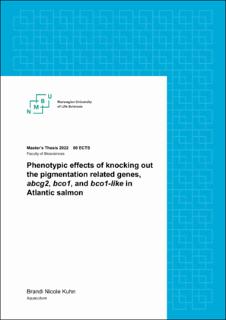| dc.description.abstract | The red muscle color is one of the main quality parameters of Atlantic salmon (Salmo salar). Unique to salmonids, the color comes from the accumulation of astaxanthin in the muscle, which is strictly obtained from the diet since salmon cannot synthesize it de novo. Despite increasingly higher dietary levels of astaxanthin, this quality trait has been slowly abating over the last decade. The diet plays a central role in the coloration together with the farming environment and genetic background which also affects muscle redness. To help understand the enigma, it is important to know how astaxanthin metabolism works in Atlantic salmon and what may affect it. Previous studies have identified that this trait to be of medium-high heritability (h2 = 0.3-0.5), identified two QTLs (quantitative trait loci) and potential causative genes which may explain differences in astaxanthin metabolism in intestine and liver. The candidate genes included abcg2, bco1, and bco1-like, all of which have been knocked out in individual lines using CRISPR/CAS9. In this thesis the different phenotypes have been characterized in order to prove causality. Analysis of specimens (200g) of each line revealed that some individuals of abcg2KO and bco1KO described modest increase in muscle color compared to the wild type controls, the latter line also revealed some specimens with a very pale muscle color. Knockout of bco1-like, however, had a large positive impact on muscle redness. These results are inline with the effect of the QTLs except for the pale bco1KO individuals. However, it is important to keep in mind that all these are mosaic founder fish with variable degree of knockout efficacy. Hence the KO efficiency was calculated using getPCR and specimens of each line with the highest KO percentage were chosen for further analysis. Formalin fixed mid intestine and liver samples were analyzed for lipid droplet content using fluorescence microscopy. Image analysis of liver showed that there was a statistically significant increase in lipid accumulation for all the KO lines, and that lipid droplet size was also affected. For liver, only abcg2KO fish described steatosis, with an increase in lipid load and droplet size. RNA sequencing and differential gene expression (DEG) analysis was carried out in the intestine and liver samples of the KO fish. In addition, corresponding samples from salmon genetically selected to be either red or pale was included in the analysis. The most important findings from DEG came from abcg2KO mid intestine and bco1KO liver. While the other KO fish showed no changes in gene expression. The abcg2KO mid intestine had 1726 genes showing differential expression with several regulated networks involving cholesterol and steroid biosynthetic processes. In addition, four genes involved in carotenoid metabolism were found moderately upregulated (logFold2 change 1.0-1.3; 1-apoA1, carm1, jun and rdh12). In the liver of the bco1KO, there was upregulation of lipid metabolic processes and metabolism with genes involving hypoxia were regulated both ways.
In summary, phenotyping the abcg2, bco1, and bco1-like CRISPR/CAS9 knockouts showed that bco1-like affects the muscle redness, with a considerable increase in color intensity. Furthermore, all investigated genes are influencing in lipid metabolism and KO of abcg2 had the greatest effect. | en_US |

